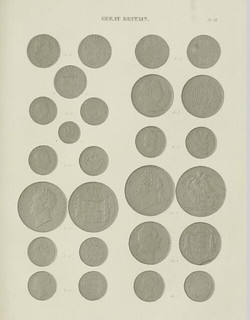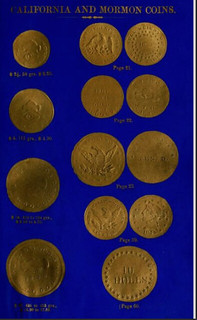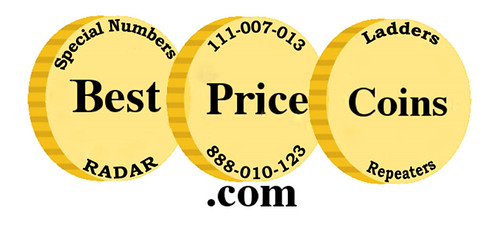
PREV ARTICLE
NEXT ARTICLE
FULL ISSUE
PREV FULL ISSUE
VOCABULARY TERM: ANAGLYPTOGRAPHY, PART 2Dick Johnson submitted this entry from his Encyclopedia of Coin and Medal Terminology - a continuation from last week. Thanks. I added two images from the Newman
Numismatic Portal. -Editor
ANAGLYPTOGRAPHY. I teased you last week by asking who won the court battle over the use of their anaglyptographic process to illustrate the book of British medals, the English or the French. Also what Mint Engraver was involved. The answers are the French publisher and Mint Engraver William Wyon. Here is the complete history and the outcome after the court ruling. History of the anaglyptograph. The medallic engraving machine was based on early 19th century models of the ruling pen and a mechanical contrivance, the Collard engraving machine, used for watch case and snuff box decoration (by FLAT ENGRAVING). In Philadelphia in 1817, Christian Gobrecht (1785-1844), developed the first successful, but primitive, medallic engraving device, even though he had been an engraver for only seven years, a craft he had taken up as a 25-year old watchmaker apprentice in Lancaster County Pennsylvania. In 1818 Gobrecht had a fellow Philadelphian build for him a somewhat more refined machine. This was accomplished by Joseph Saxton (1790-1873), a machinist, inventor, and later, constructor of weighing equipment for the U.S. Mint. Little was done with the machine for a decade, but Saxton did take it with him to London and improved upon it there in 1829. Meanwhile, an American artist and banknote engraver, Asa Spencer (ca 1805-?), had built one or more machines, based on Gobrecht’s design, and sent engravings to London. A gentleman there purchased one of Spencer’s machines, and, upon the gentleman’s death, it passed to a technician in London, John Bate. Little is known of Bate, who is described only as “optician to the admiralty,” but he is to play an important role in the story of the anaglyptograph. Bate claims to have improved upon “an existing machine” in 1830; but nowhere did he credit the machine to Spencer (or Gobrecht or Saxton) or the gentleman he acquired it from. Instead, in 1832, John Bate obtained British patent number 6254 for the medallic engraving machine (as if it was his own creation). Completely independent of these efforts, in the year 1830, a French mechanic, Achille Collas (1795- 1859), spent six months developing a medallic engraving machine after he received an order to build a ruling pen. Collas had knowledge of the Collard machine (called tour a guillocher) since it had appeared in French references as early as 1816. Collas produced his first successful engraving in 1831, but it was the following year Collas was to meet the one man who was to do more for medallic engraving than anyone else, Vincent Nolte (1779-1856). Nolte was a French businessman who recognized the commercial possibilities when shown Collas’s device. Nolte acquired the rights from Achille Collas, hired him to perform the work, and established a company to capitalize on the process. In the period 1832-34 Nolte persuaded Alexander de Lachevardiere (c1790-1855), printer, publisher of encyclopedias and Magasin Pittoresque, somewhat of a “penny magazine” of Paris, to join the venture. Lachevardiere became the manager and gave the company his name; Nolte was the firm’s major stockholder. In 1834 the company, Lachevardiere & Cie, launched one of the largest undertakings in numismatic publishing: Tresor de Numismatique et de Glyptique. The company gathered medals, coins, seals, small bas-reliefs from many sources in Europe and with Achille Collas operating his medallic engraver, created and published four folio pages and one page of text each week. An astounding enterprise, this process was to continue for 24 years and result in 20 published volumes! By 1836 this operation was underway and progressing smoothly in Paris, Nolte visited London to search for more ventures for Collas’s talents. Since medals were the primary source for the engravings, Nolte went seeking medals at the British Museum. There he had unexpected fate in being introduced to a curatorial assistant there, Edward Hawkins (1780-1867). Hawkins – who later was to become the museum’s Keeper of Antiquities and Coins – prophetically had in hand a manuscript on the medals of Great Britain. With Hawkins approval, Nolte immediately launched a drive to publish this work and to illustrate the book with medallic engravings to be prepared by his company and Collas’s machine in Paris. Nolte was unprepared for what was to transpire. News of the impending publication of a British medallic history ultimately reached John Bate, who was unhappy that a foreigner would produce the plates by the same process for which he held the British patent! – despite the fact he had done little to create or promote the machine. However, just as aggressively as Nolte sought publishers, Bate sought to block the project. Nolte finally succeeded in persuading the British Museum to publish – or at least cooperate – with a private London publisher, Charles Tilt (1797-1861) who would oversee and finance the project. The ruckus increased and led all the way to the British Parliament. Because it was a British Museum publication, it came under the jurisdiction of a committee in the House of Commons. Hearings were held, charges and countercharges; Bate versus Nolte, and each had gathered allies and experts to give testimony. It was the prominent British engraver and medallist, William Wyon (1795-1851), who was the pivot in the judicial proceedings. Nolte had shown Wyon his work, even engravings of Wyon’s own medals, and had Wyon lined up on his side. But when time came to give testimony, Wyon swung over to the Bate side and Nolte lost. By historical perspective the hearings are amusing. It was like a sub-committee of the U.S. Congress meeting to determine which engraver would be employed to produce plates for a book to be published by the Smithsonian Institution. Each party was to walk away and utilize his own machine in his own way. Both illustrated books during the mid-19th century. Nolte got in his last licks, however – he enticed Charles Tilt to publish in 1838 the book Authors of England by H.F. Chorley. This was illustrated, of course, with Collas medallic engravings of British medals of its famed writers. Nolte appended in this book, however, a long description of the House of Commons testimony, his rebuttals to Bate’s statements, and letters from everyone concerned, including Joseph Saxton who recounted Gobrecht’s early efforts in inventing the first anaglyptographic machine. Perhaps this was an attempt to prove John Bate was not the originator of the anaglyptograph, but Nolte cared little who was given credit. He wanted work for his company and to capitalize on Collas’s talents. And what of Hawkins’s manuscript? It wasn’t published until 1885, seventeen years after the author’s death. But what is even more incredible, the illustrations weren’t published until 1904-11. A delay of 68 years after Vincent Nolte wanted to commence the work! Delayed because the holder of the British patent didn’t want a foreigner, particularly a Frenchman, to prepare the engravings. Meanwhile in the early 1840s, Saxton returned to Philadelphia to work for the U.S. Mint. In addition to building new scales he built an even more improved anaglyptograph based on the tracing machine Gobrecht had used in 1835 for the Liberty Seated dollar. (Gobrecht was unable to use this for another coin design because he died in 1844).   RIGHT: Plate from New Varieties of Gold and Silver Coins, 1850 Edition Saxton’s machine was steam powered and automatic; an operator did not need to reset it constantly. It was used to prepare engravings for two books, published in 1842 and 1846, by the two assayers at the Philadelphia Mint, Jacob B. Eckfeldt (1803-1872) and William E. Du Bois (1810-1881). These were A Manual of Gold and Silver Coins of All Nations and New Varieties of Gold and Silver Coins, Counterfeit Coins, and Bullion. Also two other Americans had taken an interest in anaglyptographic engravings, both steel banknote engravers, James W. Steel (1799-1879) and Waterman Lilly Ormsby (1809-1883). Both of these gentlemen had built or acquired medallic engraving machines. Orsmby was a prominent banknote engraver, foe of forgers, founder of the Continental Bank Note Company, and author of a number of books on these subjects. He maintained that the greatest use of anaglyptographic engravings was – not for book illustrations – but for banknote vignettes. He reproduced anaglyptographic samples, described the process, but we are mostly indebted to him for illustrating his anaglyptograph machine in his 1852 book, A Description of the Present System of Bank Note Engraving. A few books and journals were illustrated with anaglyptographic engravings in the U.S. after the Civil War, but the far larger use by then was banknote vignettes. Nevertheless, the process rapidly fell into disuse in the 1880s with the rise of photoengraving – making printers’ plates from photographic prints – with a continuous tone (as in colotype or heliotype), or a screened process (as in halftone). To read the earlier E-Sylum article, see: To read the books on the Newman Numismatic Portal, see: Looking for the meaning of a numismatic word, or the description of a term? Try the Newman Numismatic Portal's Numismatic Dictionary at: https://nnp.wustl.edu/library/dictionary  Wayne Homren, Editor The Numismatic Bibliomania Society is a non-profit organization promoting numismatic literature. See our web site at coinbooks.org. To submit items for publication in The E-Sylum, write to the Editor at this address: whomren@gmail.com To subscribe go to: https://my.binhost.com/lists/listinfo/esylum All Rights Reserved. NBS Home Page Contact the NBS webmaster 
|